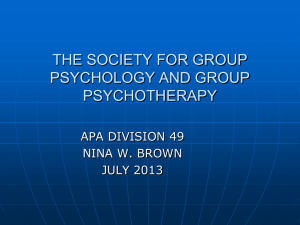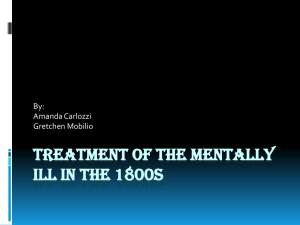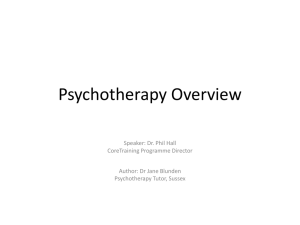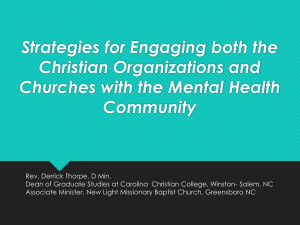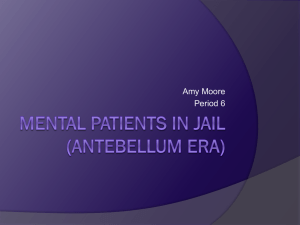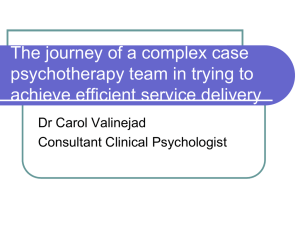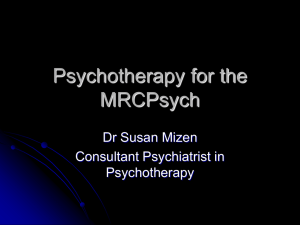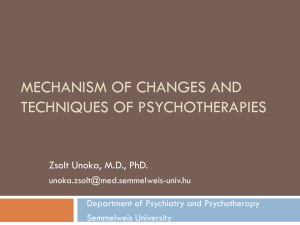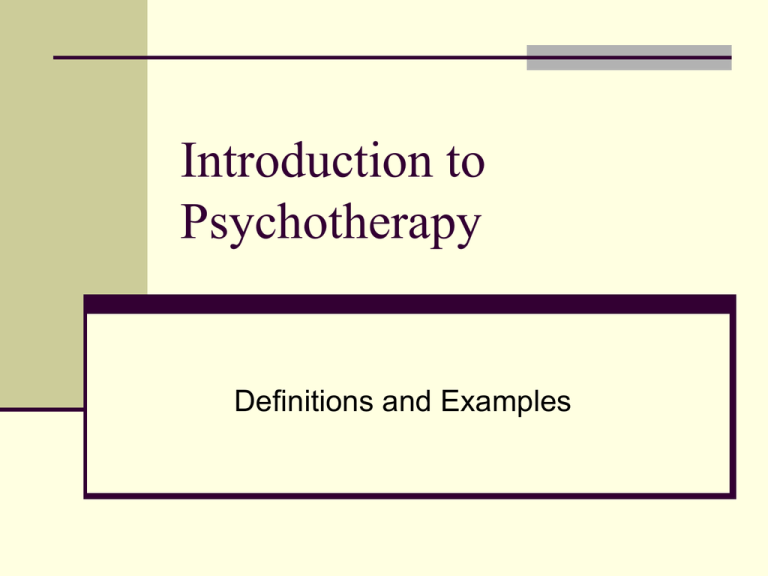
Introduction to
Psychotherapy
Definitions and Examples
The 5-minute lecture
The 5-minute university [video link]
Mental health “treatment” has a painful history
Contemporary psychotherapy works
The relationship is important
Therapist must be empathic
Therapy is an art (as well as a science)
There are many therapy modalities. People
like to argue about which one is best.
Today’s Lecture
Historical
treatment of the mentally ill
Psychotherapy definitions and examples
Places of treatment
Providers of treatment
Recipients of treatment
Historical background:
Beliefs and treatment of the mentally ill
Greek physician Hippocrates (ca. 400BC)
promoted humane treatment. Tx based on
healing powers of nature: Mentally ill
patients were placed in pleasant
surroundings and given soothing baths.
Lack of balance between positive and
negative energies
Illness attributed to a disturbance in the
balance of bodily fluids (humorism).
Humour
Season
Organ
Ancient name
Modern
MBTI
Ancient characteristics
Blood
spring
liver
sanguine
artisan
SP
courageous, hopeful, amorous
Yellow bile
summer
spleen
choleric
idealist
NF
easily angered, bad tempered
Black bile
autumn
gall bladder
melancholic
guardian
SJ
despondent, sleepless, irritable
Phlegm
winter
brain/lungs
phlegmatic
rational
NT
calm, unemotional
Middle Ages-17th century: A spiritual matter
Madness = in league with devil,
possession by spirits
Diagnosis based on hearsay,
unreliable “tests”
Treatment
Prayer, exorcism, magic incantation
Torture, starvation, and exile (sent to sea)
Treated like animals and sentenced to
burn or hang
th
18
century: Moderate enlightenment
Mentally disordered people =
degenerates
Treatment:
Isolate mentally ill from society
Sometimes bloodletting
The 19th century: Attempts at reform
Philippe Pinel (1745-1826)
Reformed Paris mental
hospitals: Removed
restraints and treated
mentally ill more humanely
Some patients got better
enough to leave hospital
The 19th century (cont.)
Dorothea Dix (1802-1887)
Reform of U.S. system
Moral-treatment movement
advocating humane care
Led to large, state-supported
public asylums
But problems persisted
Overcrowding
No effective treatments
Eventually…interest waned
Freud introduces psychoanalysis in 1890s
The 20th century
New biological therapies introduced in 1930s
Insulin-coma therapy (ICT) video of Leonard Frank
Electro-shock therapy (ECT) video of early ECT
Frontal lobotomy video
Anti-psychotic drugs introduced in mid-1950s
Deinstitutionalization follows in early 1960s
get people out of asylums and back into community
general mood of optimism in country
Community mental health centers established in 1961
Additional video available from Scientific American Series
ECT Today
Therapy for severely
depressed patients in which
a brief electric current is sent
through the brain of an
anesthetized patient
Side effects of ECT include
slowing of information
processing speed and shortterm memory loss, but it is
painless and there is no risk
for death or brain damage.
70% of depressed patients
who did not respond to other
treatment respond positively
to ECT.
Somatic Treatments in the 1920s and 1930s
The 20th century
New biological therapies introduced in 1930s
Insulin-coma therapy (ICT)
Electro-shock therapy (ECT)
Frontal lobotomy
Anti-psychotic drugs introduced in mid-1950s
Deinstitutionalization follows in early 1960s
get people out of asylums and back into community
general mood of optimism in country
Community mental health centers established in 1961
Additional video available from Scientific American Series
Patients in Mental Hospitals. The number of patients cared for in the U.S.
state and county mental hospitals has decreased dramatically since 1955.
20th Century:
Advances in psychotherapy
Psychoanalysis introduced by Freud in 1890s
Adler (1930s) and other neo-Freudians follow
Variety of new approaches introduced in 1950s
Behavioral (Wolpe, Watson, Skinner)
Rational Emotive Therapy (RET, Ellis)
Humanistic (Rogers)
Existential (May)
Gestalt (Perls)
Cognitive therapy introduced in 1960s (Beck)
Group therapy also gains popularity in 1960s
Family Therapy comes in the 1970s
Motivational Interviewing (1983) and MBCT (1991)
Today’s Lecture
Historical
treatment of the mentally ill
Psychotherapy definitions and examples
Places of treatment
Providers of treatment
Recipients of treatment
What is psychotherapy?
Psychotherapy is a form of treatment for problems
of an emotional nature in which a trained person
deliberately establishes a professional relationship
with a patient for the purpose of removing,
modifying, or retarding existing symptoms, of
mediating disturbed patterns of behavior, and of
promoting positive personality growth and
development (Wolberg, 1967).
Psychotherapy is a planned activity of the
psychologist1, the purpose of which is to accomplish
changes in the individual that make his/her life
adjustments potentially happier, more constructive,
or both (Frank, 1982).
1 or other professional mental health service provider
Which of these is not psychotherapy?
A rabbi counseling a couple with marital difficulties
An abused child drawing pictures of his family for a
psychologist
A woman presenting her testimony to her Alcoholic
Anonymous group
A university Counseling Center psychologist with an
M.A. helping a student choose a career
A man talking about his dreams and childhood
experiences to a psychoanalyst in N.Y.
A police officer “talking down” a suicidal teenager
from a tall building
A family having a loud argument in a therapist’s office
Today’s Lecture
Historical
treatment of the mentally ill
Psychotherapy definitions and examples
Places of treatment
Providers of treatment
Recipients of treatment
Modern Treatment Facilities/Trends
Hospitals (2006 National Hospital Discharge Survey)
Mental disorders led to 2.4 million hospitalizations (6.9% of total)
Psychoses was the 3rd most common reason for hospitalization
Heart disease (4.2 million)
Child delivery (4.1 million)
Psychoses (1.7 million)
Pneumonia (1.2 million)
Malignant neoplasms (1.2 million)
Fractures (1.1 million)
Average length of st-hospital stay is about 7 days (see next slide)
Community Mental Health Centers
Out-patient mental health clinics
Nursing homes
Private offices
Hospitals from a patient's perspective
Rosenhan (1973): "On being sane in insane places”
sane people got into mental hospitals as patients
found very low interaction with staff
dehumanizing nature of interactions
normal behaviors interpreted pathologically
Brief interview with Rosenhan
Rosenhan’s study spurned significant reform. Today’s
hospitals are more humane, but…
Diagnosis rules the day (a critique)
Practically everyone is medicated
Restraints & padded rooms used if patient at risk of self-harm
Involuntary hospitalization legally permitted (though limited)
Modern Treatment Facilities/Trends
Hospitals (2004 National Hospital Discharge Survey)
Mental Disorders accounted for 2.3 million hospitalizations
Psychoses was the 3rd most common reason for hospitalization
Heart disease (4.4 million)
Child delivery (4.1 million)
Psychoses (1.6 million)
Pneumonia (1.3 million)
Malignant neoplasms (1.2 million)
Fractures (1.0 million)
Average length of hospital stay is about 7 days (see next slide)
Community Mental Health Centers
Out-patient mental health clinics
Nursing homes
Private offices
Today’s Lecture
Historical
treatment of the mentally ill
Psychotherapy definitions and examples
Places of treatment
Providers of treatment
Recipients of treatment
Professionals who treat mental disorders
Psychiatrists (M.D.)
Psychiatric nurses (B.S, M.S.)
Physicians (M.D.)
Psychoanalysts (Ph.D. +)
Psychologists
Clinical (M.A., Ph.D., Psy.D.)
Counseling (M.A., Ph.D.)
School (M.A., Ph.D.)
Social workers (MSW)
Marriage and family counselors (M.A.)
Therapists and their training
Estimated Number of Clinically Trained Professionals
Providing Mental Health Services in the U.S.
(2010)
Psychiatrists
Clinical, Counseling, and School Psychologists
Social Workers
Current data
available on the
Occupational
Outlook Handbook
homepage
Self-help Groups
Referral sources
Who do people recommend?
Who do people turn to for help?
Types of psychotherapists
Types of psychotherapists (part 2)
Psychodynamic
CBT
H/G/E
Systems
Eclectic
Norcross, Hedges, & Prochaska (2002)
Adapted from Norcross, J. C., Hedges, M., & Castle, P. H.
(2002). Psychologists conducting psychotherapy in 2001: A
study of the Division 29 membership. Psychotherapy:
Theory, Research, Practice, Training, 39(1), 97–102.
Today’s Lecture
Historical
treatment of the mentally ill
Psychotherapy definitions and examples
Places of treatment
Providers of treatment
Recipients of treatment
Recipients of treatment
Most people who meet criteria for DSM
diagnoses do not seek treatment
Variability due to sex, education, race &
income level
women seek more treatment than men
college educated people seek more treatment
than those with only a high school education
whites seek more treatment than nonwhites
people with higher income seek more
treatment than those with lower income
Race-group Differences in Psychopathology
Distribution lacking health insurance
by race and ethnicity (2004)
Latest
uninsured
data from
CFED
The higher uninsured rate for Hispanics is not associated with higher poverty
levels than other groups — the poverty rate for Hispanics is slightly lower than
for African-Americans, 22.2% vs. 24.9% respectively. Rather, research has
shown that Hispanics are more likely to be employed in jobs that do not offer
health insurance…but when offered health insurance they accept at the same
rates at whites and blacks (U.S. Department of Health and Human Services)
More research on
health disparities
Reasons for seeing a mental health professional
Murstein & Fontaine (1993), random sample in Conn.
More information:
APA Psychology career page
Occupational Outlook Handbook
See “Professional Development” links on
course website


